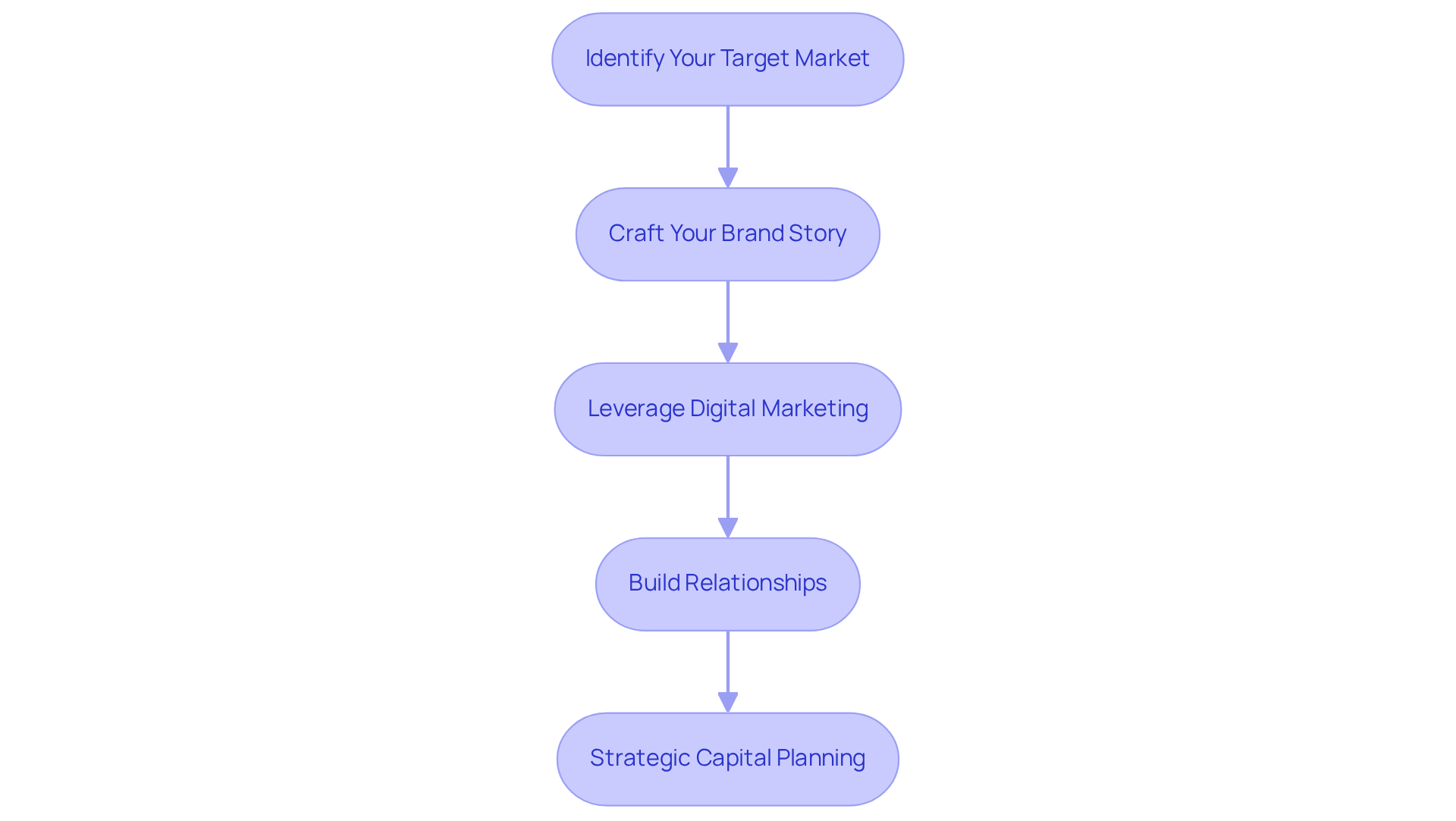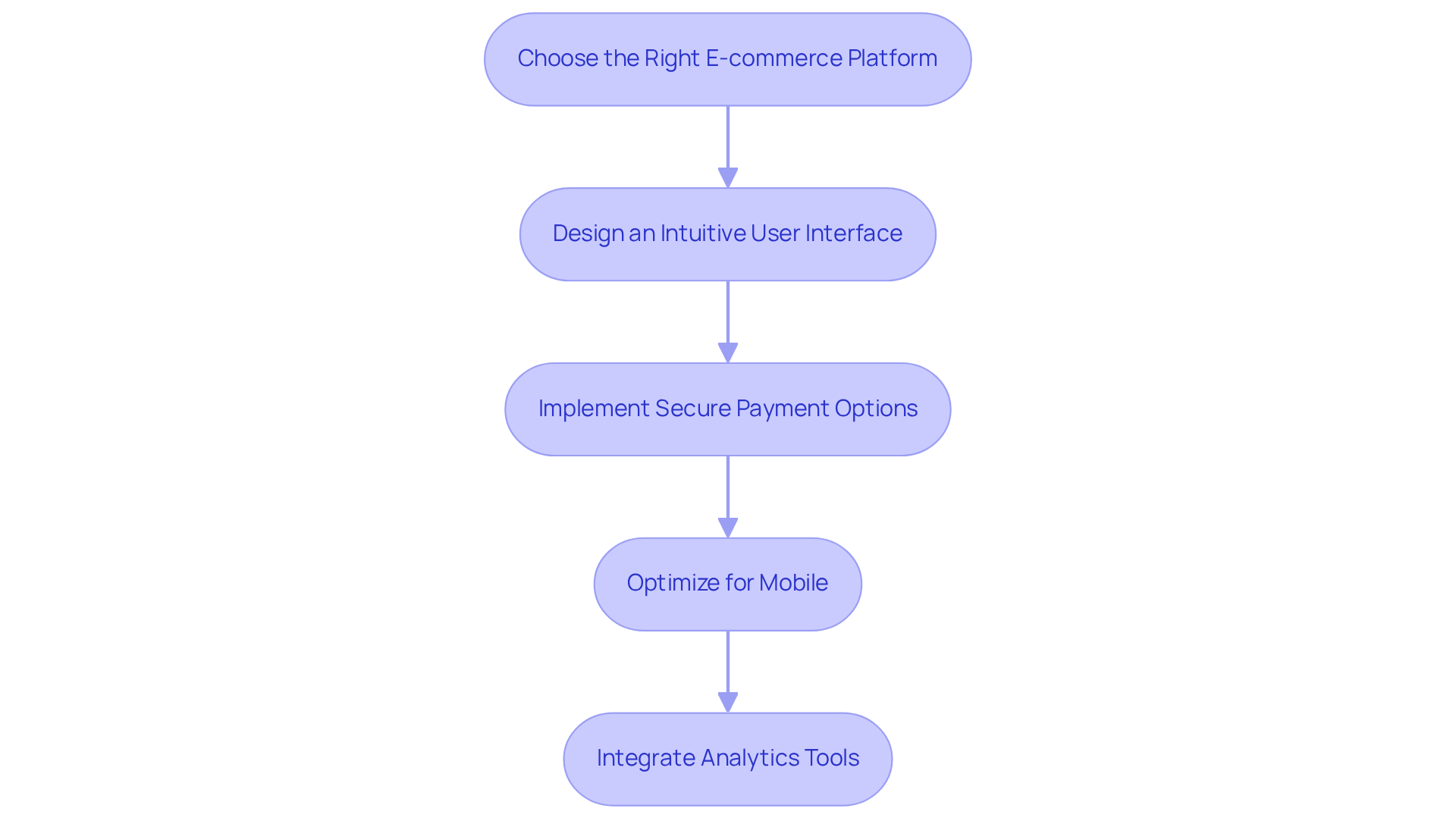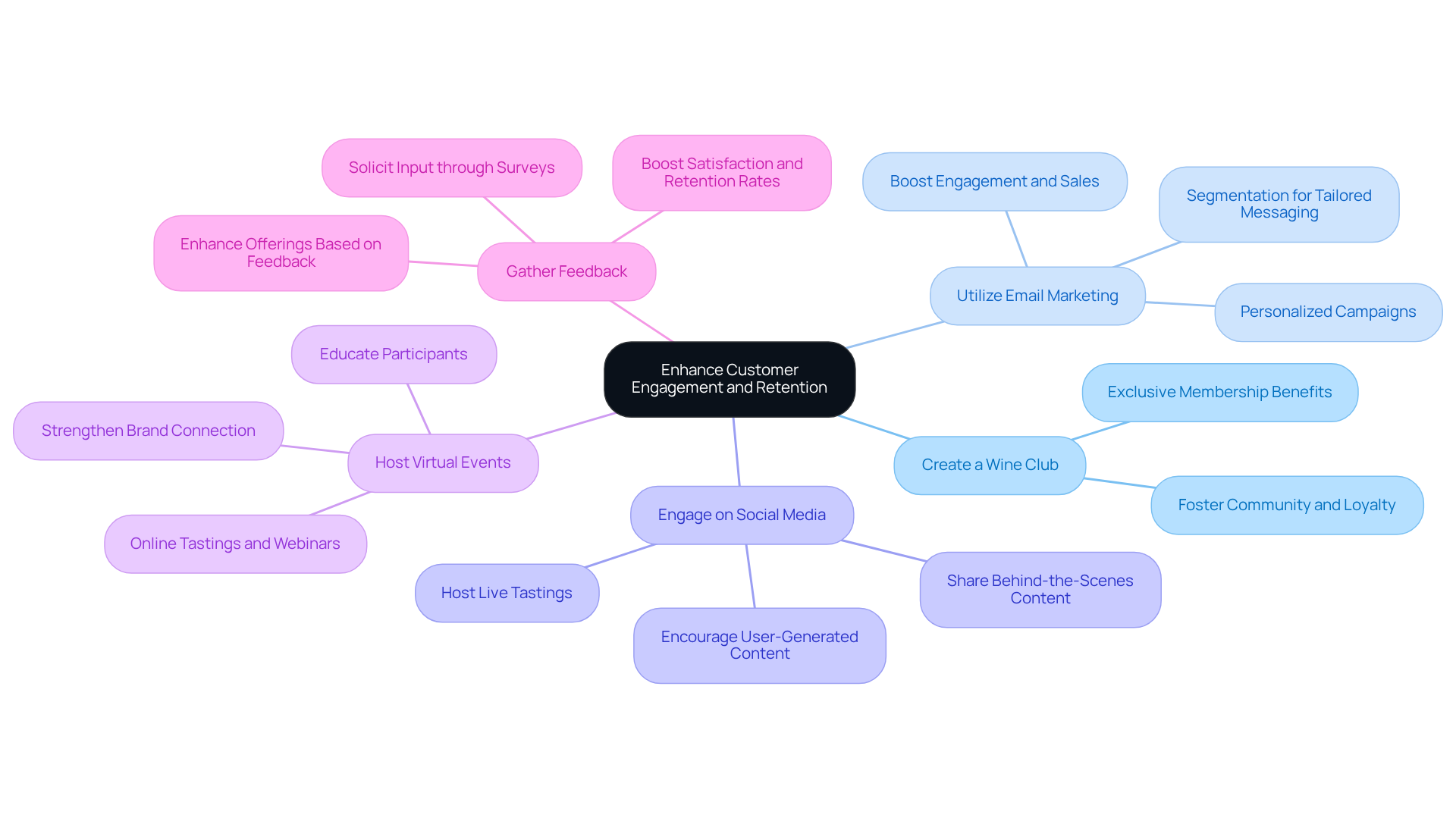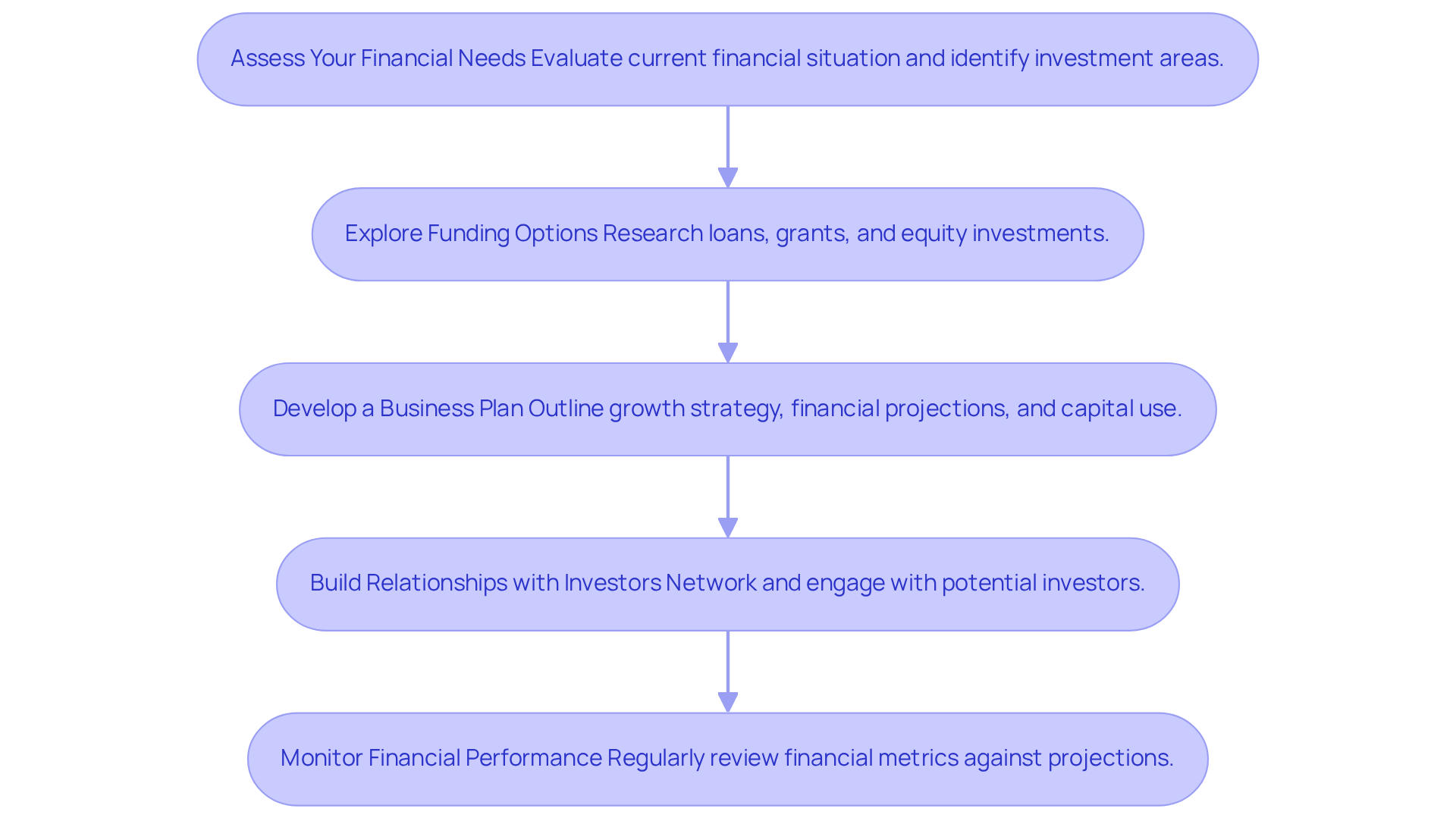Overview
The article presents four critical steps for successfully selling wine online and enhancing customer engagement. It emphasizes the importance of:
- Understanding the target market
- Optimizing the online sales platform
- Improving customer retention
- Implementing strategic capital planning
Each step is backed by actionable strategies, including leveraging digital marketing and crafting engaging brand narratives. These elements are essential for attracting and retaining customers in a competitive marketplace.
Introduction
Selling wine online has emerged as a crucial strategy for wineries striving to excel in a competitive landscape. As consumer preferences increasingly lean towards personalized experiences and authentic brand narratives, it is imperative for wineries to evolve their approaches to effectively engage their audience. How can they successfully navigate the complexities of direct-to-consumer sales while cultivating enduring customer relationships? This article delves into four actionable steps designed not only to enhance online sales but also to elevate customer engagement, paving the way for sustainable growth within the wine industry.
Understand Direct-to-Consumer Sales Strategies
To effectively sell wine online, it is essential to embrace sales strategies that prioritize and their preferences. Research indicates that consumers increasingly seek and authentic brand stories, making it crucial for wineries to adapt. Notably, 27% of new wine club signups originate from digital channels, highlighting the importance of a strong online presence to sell wine online. Here are actionable steps to enhance your DTC strategy:
- Identify Your Target Market: Conduct a thorough analysis of the demographics, preferences, and purchasing behaviors of your ideal customers. Utilize surveys, social media insights, and analytics tools to gather valuable data that informs your marketing approach.
- Craft Your Brand Story: Develop a compelling narrative that encapsulates your establishment's heritage, values, and unique offerings. This story should resonate with your audience and be consistently reflected across all marketing channels, enhancing brand loyalty and engagement. , helping wineries connect with consumers and drive sales through storytelling.
- Leverage Digital Marketing: Harness the power of social media, email marketing, and content marketing to connect with your audience. Share engaging content that not only showcases your wines but also highlights the experiences they offer, fostering a deeper connection with potential buyers. Proven can transform casual buyers into loyal club members, driving consistent growth and contributing to an .
- Build Relationships: Focus on engaging clients through personalized communication. Respond quickly to inquiries and establish loyalty programs that reward repeat purchases, enhancing retention and satisfaction. can assist vineyards in optimizing their clubs and improving loyalty.
Additionally, consider to ensure long-term sustainability. As Rob McMillan, EVP and founder of the SVB Wine Division, emphasizes, understanding your target audience is vital for success in DTC sales. By creating a strong DTC strategy, wineries can effectively sell wine online, increase sales, and improve client engagement, ultimately fostering sustainable growth in a competitive market.

Establish and Optimize Your Online Sales Platform
To effectively , it is crucial to establish and optimize your . Here’s how to achieve this:
- Choose the Right E-commerce Platform: Select a platform that aligns with your business needs, such as Shopify or WooCommerce. These platforms provide , diverse payment options, and scalability to grow alongside your business.
- Design an Intuitive User Interface: Your website must be . High-quality images and detailed descriptions of your wines significantly enhance . A well-designed interface not only attracts visitors but also encourages them to delve deeper into your offerings.
- Implement Secure Payment Options: Build trust with your clients by offering various , including credit cards and PayPal. Ensuring your site is secure is essential for protecting client information and fostering confidence in your brand.
- Optimize for Mobile: With an increasing number of consumers shopping on mobile devices, it is vital to ensure your website is mobile-friendly. Test the user experience across various devices to guarantee functionality and ease of use.
- Integrate : Utilize tools like Google Analytics to monitor visitor behavior, sales trends, and conversion rates. This data is invaluable for making informed decisions that enhance your platform's performance.
By creating a robust online sales platform, you lay the groundwork to and improve client engagement. Statistics indicate that businesses utilizing effective can experience substantial growth, with some clients witnessing an average e-commerce increase of 191% in recent years. This underscores the importance of a well-optimized online presence in today’s competitive market.

Enhance Customer Engagement and Retention
To enhance , wineries that must implement that resonate with their audience.
- : Establish exclusive memberships that offer benefits such as discounts, early access to new releases, and members-only events. This approach fosters a sense of community and loyalty, which is crucial for in a competitive market.
- : Implement personalized email campaigns that provide updates, promotions, and educational content about your beverages. Segmenting your email list allows for tailored messaging, significantly . In fact, 27% of new club signups now come from digital channels, underscoring the importance of a strong online presence.
- Engage on Social Media: Leverage platforms like Instagram and Facebook to share behind-the-scenes content, host live tastings, and interact with your audience. Encouraging user-generated content amplifies your reach and fosters authentic connections with consumers, particularly among Millennials and Gen Z, who prioritize customization and engagement.
- : Organize online tastings or webinars that educate participants about your wines and the winemaking process. These events not only provide valuable information but also strengthen the connection between your brand and its audience, thereby .
- Gather Feedback: Regularly solicit input from clients through surveys or reviews. This practice enhances your offerings and demonstrates that you value client feedback, which can significantly boost satisfaction and retention rates.
By applying these strategies, vineyards can cultivate a dedicated clientele that drives their advancement and success as they seek to sell wine online for years to come.

Implement Strategic Capital Planning for Growth
To ensure sustainable growth, it is imperative to implement by following these essential steps:
- Assess Your Financial Needs: Start by thoroughly evaluating your current financial situation. Identify critical areas for investment, such as marketing, production, or technology enhancements. This assessment is vital; businesses that consistently monitor their cash flow and liquidity can adeptly navigate financial challenges and secure necessary funding.
- : Conduct comprehensive research into various funding sources, including loans, grants, and equity investments. Each option presents distinct advantages and disadvantages, so it is crucial to consider how they align with your establishment's long-term goals. For example, agricultural loans typically range from 1.5% to 5%, while SBA loans may have interest rates between 5% and 9%. Understanding these options empowers you to make informed decisions.
- : Formulate a comprehensive business plan that outlines your growth strategy, financial projections, and intended use of capital. This document is essential when approaching potential investors or lenders, as it showcases your establishment's potential and preparedness. Wineries that and adopt , including regular budget reviews, significantly enhance their chances of securing financing.
- Build Relationships with Investors: Networking with potential investors and stakeholders in the wine industry is crucial. Attend industry events and engage in discussions to highlight your winery's potential. Building solid connections can lead to or venture capital, which are essential to sell wine online.
- Monitor : Regularly review financial performance against projections. This continuous evaluation allows you to adjust strategies as necessary, ensuring alignment for progress. Wineries that consistently track key metrics, such as cash flow and debt service requirements, position themselves better for future opportunities.
By implementing strategic capital planning, supported by , you position your establishment for sustainable development and the ability to seize new opportunities in an evolving market. Ready to Transform Your Winery's Growth? Schedule a complimentary 30-minute growth audit to discover opportunities specific to your winery's unique situation.

Conclusion
Selling wine online necessitates a strategic approach that prioritizes direct-to-consumer (DTC) sales alongside customer engagement. By grasping the unique preferences of the target audience and crafting a compelling brand narrative, wineries can forge a meaningful connection with consumers. This connection is further amplified through effective digital marketing, a user-friendly online sales platform, and personalized customer interactions.
Key strategies include:
- Identifying the target market
- Optimizing e-commerce platforms
- Implementing customer engagement initiatives such as wine clubs and virtual events
Each of these elements is vital in fostering loyalty and driving sales growth. Moreover, strategic capital planning ensures that wineries are well-prepared to navigate financial challenges and seize new opportunities in the evolving market.
Ultimately, the journey to successfully sell wine online transcends merely offering products; it revolves around creating an engaging experience that resonates with consumers. Wineries that adopt these strategies will not only enhance their sales but also cultivate enduring relationships with their customers, ensuring sustainable growth in a competitive landscape. The time to innovate and bolster online presence is now—taking these steps can lead to significant advancements in the wine business.
Frequently Asked Questions
What is the importance of direct-to-consumer (DTC) sales strategies in selling wine online?
DTC sales strategies are essential for selling wine online as they focus on understanding the target audience and their preferences, which is crucial for creating personalized experiences and authentic brand stories.
What percentage of new wine club signups come from digital channels?
Notably, 27% of new wine club signups originate from digital channels, highlighting the importance of a strong online presence.
How can wineries identify their target market?
Wineries can identify their target market by conducting thorough analyses of demographics, preferences, and purchasing behaviors using surveys, social media insights, and analytics tools.
Why is crafting a brand story important for wineries?
Crafting a brand story is important because it encapsulates the establishment's heritage, values, and unique offerings, resonating with the audience and enhancing brand loyalty and engagement.
What digital marketing strategies should wineries leverage?
Wineries should leverage social media, email marketing, and content marketing to connect with their audience and share engaging content that showcases their wines and the experiences they offer.
How can wineries build relationships with their clients?
Wineries can build relationships by engaging clients through personalized communication, responding quickly to inquiries, and establishing loyalty programs that reward repeat purchases.
What role does strategic capital planning play in DTC sales?
Strategic capital planning for debt, equity, or acquisition opportunities is important for ensuring long-term sustainability in DTC sales.
What is the potential growth in e-commerce for wineries using effective DTC strategies?
Proven DTC strategies can drive e-commerce growth of up to 191%, transforming casual buyers into loyal club members.
What is the key takeaway from Rob McMillan regarding DTC sales?
Rob McMillan emphasizes that understanding the target audience is vital for success in DTC sales.




